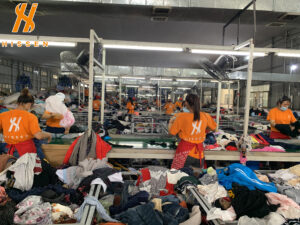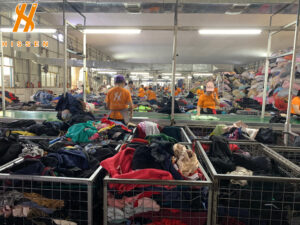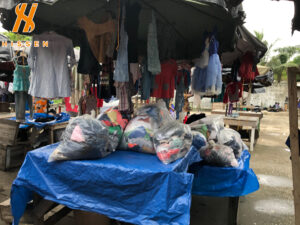What is the current prospect of second-hand clothing in the African market?
Second-hand clothing in the African market. In the crowded markets of Africa and on the sidewalks of African cities and towns. Shoppers can buy second-hand clothing from various brands around the world at low prices. Customers bargain to buy as many clothes as possible at the lowest possible cost. This is very common throughout Africa. Countries such as Ghana, Nigeria, Côte d’Ivoire, Tanzania, Benin, Uganda, and Keny are Africa’s largest second-hand clothing markets.

The second-hand clothing comes mainly from charity shops or thrift stores in Europe, the United States, and other countries. Data shows that Kenya alone imports about 100,000 tons of second-hand clothing each year. They provide the government with tariff revenue and creates tens of thousands of jobs. Besides, it also provides Kenyans with high-quality clothing at lower prices.
What has promoted the prosperity of the second-hand clothing market in Africa?
The African second-hand clothing market was still begainning when the trade liberalization policy introduced in the late 1980s . And early 1990s opened up a new era of competition in the local African apparel industry. Because until the 1980s, the implementation of high tariff policies had protected local African textile.
With the support of the International Monetary Fund, economic liberalization programs began to take root in African countries. With lower import tariffs, local textile and garment factories had to deal with new competition. At that time, many African garment factories failed and closed down.
Although they import the new outfits from counrties. Such as China has become a better alternative, complaints about its poor quality are clearly beneficial to exporting second-hand clothing to Africa. With the rapid economic development of China,resulting in textile waste has become the anguish of The Chinese people. Even though some of these clothes can be donated to people, the problem of textile waste has not been improved.
As a result, exporting used clothes to Africa has become one of the most effective ways for the Chinese to deal with textile waste. Chinese clothes are mainly from developed cities. And the quality of their clothes have various styles. At the same time, these companies in the export trade have professional purchasing, sorting and sales teams. Such as Hissen Trading Co., LTD., Zagumi Trading Co., LTD

How to sell second-hand clothing to the African market?
Exporters, wholesalers, and traders can engage in the business of buying。 And selling second-hand clothing and easily earn up to millions of dollars. Usually, these garments would pack with 45-kilogram capacity bags and load into containers— a standard 40-foot container can hold about 550 bales of these clothes, which is equivalent to 25 tons of clothing.
Customs officers impose tariffs at different African ports and charge fees for each container. At the same time, the city tax bureau also collects taxes on informal vendors and stores that sell second-hand clothes.
Critics of the industry argue that Africa will not be able to establish its own textile and apparel industry well when a large amount of cheap imported second-hand clothing floods into the country. In fact, after banning the import of second-hand clothing, Rwanda is currently engaged in diplomatic negotiations with the United States. The U.S. responded that it would suspend Rwanda taking of the benefits of the U.S.’s trade plan African Growth and Opportunity Act (AGOA). AGOA allowed sub-Saharan African countries to export duty-free to the U.S., reducing trade barriers to the U.S. trade barriers in return.
Experts’ attitude towards second-hand clothes
Although the second-hand clothing import ban was approved by the leaders of the East African Community, Uganda, Kenya, and Tanzania bowed to pressure and chose to continue to enjoy the economic benefits of AGOA. Only Rwanda enforced the ban alone.
Rajeev Arora, head of the African Cotton and Textile Industry Federation, said that up to 85% of Kenya’s textile mills have been closed since the early 1990s. The cotton production now is only one-tenth of the level of the 1990s. Although cotton, as an essential raw material for manufacturing clothing, is massively planted in Mali, Burkina Faso, Chad, Togo, and Uganda, these countries are still one of the most thriving markets for second-hand clothing sales.
However, other experts said that it was not the import of second-hand clothing that caused the closure of African textile and garment factories, but the low production efficiency. Although researchers believe the second-hand clothing trade may employ hundreds of thousands of people, the informal nature of this trade makes it difficult to estimate an accurate number.
And many banks have recognized the opportunities presented by the second-hand clothing business in Africa, setting up branches near second-hand markets to provide traders with convenient services.
According to the China-Africa Trade Research Center, second-hand clothing from many developed countries dominates the local market stalls in sub-Saharan Africa. Throughout the African continent, second-hand clothing is the mainstay of informal trade. It even occupies the majority of the market for clothing sales in some African countries. In Nigeria, they usually call it as “kafa ulaya”; and in Mozambique, they are often call as “roupa da calamidade.”

The attitude of the African market towards the second-hand clothing trade
However, due to the mismatch between second-hand foreign clothing and local African residents’ fashion preferences and body shapes, as well as considerations of health and dignity, the dispute over the import ban on second-hand clothing in Africa has never stopped. At present, some southern African countries such as Zimbabwe have begun to ban the import of second-hand underwear. And other products. And East Africa has the strongest feelings about the second-hand clothing import ban, especially the representative to Rwanda.
Rwanda has experienced an economic rebound in the past decade. As part of its efforts to become a middle-income country by 2020. It is trying to nurture a clothing industry, hoping to create 25,000 jobs.
conclusion
The cost of selling second-hand clothing is much lower than the production cost of local clothing factories in Africa. In response, East African Community member states Kenya, raised import tariffs on second-hand clothing in July 2016. Rwanda increased the import duties from 20 cents to $2.50 per kilogram.
